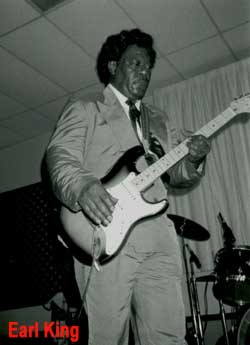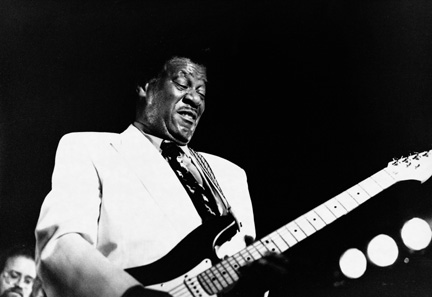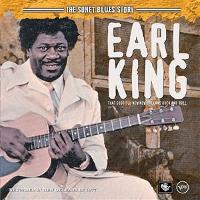Posts tagged dwmg.com
Mardi Gras Music Series: EARL KING
0I’ve been a big fan of Earl King since moving to New Orleans in the middle 1970’s. I remember seeing Earl at the Jazz Fest in the late 1970’s. He was a true R&B powerhouse. I purchased a copy of the Trick Bag album, it was 1 of the top 5 New Orleans R & B tunes for me, along with Tell It Like It Is, Go To The Mardi Gras, Cha Dookie-Doo, and Mardi Gras Mambo.
Unilaterally respected around his Crescent City birthplace as both a performer and a songwriter, guitarist Earl King was a leading New Orleans R&B force for more than 4 decades.
Mardi Gras tune- Street Parade by Earl King
Born Earl Johnson, the youngster considered the catalogs of Texas guitarists T-Bone Walker and Gatemouth Brown almost as fascinating as the live performances of local luminaries Smiley Lewis and Tuts Washington. King met his major influence and mentor, Guitar Slim, at the Club Tiajuana, one of King’s favorite haunts (along with the Dew Drop, of course). The two instantly became friends. Still performing under the name Earl Johnson, the guitarist debuted on wax in 1953 on Savoy with “Have You Gone Crazy.” On this record, longtime pal Huey “Piano” Smith made the first of his many memorable supporting appearances.
In the world of the Blues the name of “King” is highly respected. Most fans associate the surname with the obvious “Big 3,” Albert, B.B. and Freddie. But in New Orleans, the residents know there is a 4th that deserves his place alongside these 3: Earl King.
Earl King was more than just a musician. He was a renaissance man. During his nearly 5 decade career, he wore many hats: guitarist, vocalist, songwriter, producer, sideman, arranger and mentor. He was prolific in his output, perhaps only rivaled by Allen Toussaint for recognizable material. His songs have been covered by the likes of Fats Domino, Jimi Hendrix, Stevie Ray Vaughan, The Meters, Johnny Adams, Professor Longhair and many more. And unlike many other artists of his generation, he profited from the royalties gained by those who covered his songs as he had wisely retained the copyrights to his work.
He was born in New Orleans as Earl Silas Johnson on February 6, 1934. Raised in the city’s Irish Channel neighborhood, his father was a Blues pianist who was a close acquaintance with the locally renowned Tuts Washington. But Earl’s father died when he was still quite young and he was raised in a single-parent home by his mother, a heavy-set woman known affectionately as “Big Chief.”
Earl’s musical life began in the family church. He participated in the choir singing Gospel. But one day while walking through the neighborhood he heard the guitar playing of Smiley Lewis emanating from a bar. The music enchanted him and he sought means to express his singing outside of the church.
Pianist Huey Smith heard the teenager sing and decided to hire him for his band. Needing another vocalist and musician, he convinced Earl to pick up the guitar.
Johnson became Earl King upon signing with Specialty the next year. Label head Art Rupe intended to name him King Earl, but the typesetter accidentally reversed the names. A Mother’s Love, King’s first Specialty offering, was an especially accurate Guitar Slim homage produced by Johnny Vincent, who would soon launch his own label, Ace Records, with King one of his principal artists. King’s first Ace single, the seminal two-chord south Louisiana blues Those Lonely, Lonely Nights, proved a national R&B hit (despite a sound-alike cover by Johnny “Guitar” Watson). Smith’s rolling piano undoubtedly helped make the track a hit.
I notice this Trick Bag album is on the Sonet label, that’s a Scandinavian label, I knew the owners, and did business with the Storyville label for many years. It was sold to Polygram and for a decade they buried the label.
King remained with Ace throughout the rest of the decade, recording an unbroken string of great New Orleans R&B sides with the unparalleled house band at Cosimo’s studio. He later moved to Imperial to work with producer Dave Bartholomew in 1960, cutting the classic Come On (also known as Let The Good Times Roll) and 1961’s humorous Trick Bag. He managed a second chart item in 1962 with Always a First Time. King wrote standout tunes for Fats Domino, Professor Longhair, and Lee Dorsey during the 1960s.
Although a potential 1963 pact with Motown was scuttled at the last moment, King admirably rode out the rough spots during the late ’60s and ’70s. In the 1990s, he rejuvenated his career by signing with Black Top; Sexual Telepathy and Hard River to Cross were both superlative albums.After releasing well over 100 albums, the label folded in 1999. Nauman Scott died in 2002. Hammond Scott sold the rights of the catalog, and some releases were reissued on labels such as Varèse Sarabande, Fuel 2000 and Shout! Factory. In 2006, P-Vine Records in Japan acquired the worldwide rights to them, and has reissued a few of the CD’s from the catalog.
In 2001, King was hospitalized for an illness during a tour to New Zealand, however, that did not stop him from performing. In December of the same year, he toured Japan, and he continued to perform off and on locally in New Orleans until his death.
He died on April 17, 2003, from diabetes related complications, just a week before the New Orleans Jazz & Heritage Festival. His funeral was held during the Festival period on April 30, and many musicians including Dr. John, Leo Nocentelli and Aaron Neville were in attendance.[4] His Imperial recordings, which have been long out-of-print, were reissued on CD soon after he died. The June 2003 issue of a local music magazine OffBeat paid a tribute to King by doing a series of special articles on him.
Mardi Gras Music Series- PROFESSOR LONGHAIR
0I’m very very partial to the tunes and Mardi Gras Spirit of Professor Longhair. When I first arrived in NOLA in the mid 70’s, Fess very much alive, and I remember seeing Fess live at Tipitina’s many times. It wasn’t until Longhair had been dead for 15 years that his music really took off. That’s when I got involved in the Longhair estate professionally and made sure his heirs would be properly taken of. I went to the south Riviera of France, to MIDEM, the premier music publishing conference after setting up meetings with international roots publishers I knew. I met with Don Williams (dwmg.com). He owned some great roots music catalogs, but none from New Orleans. He was very interested in the Longhair publishing sale. Within a few years, he purchased Longhair, Booker, and Earl King’s publishing catalogs. All 3 had songs in all 3.5 seasons of Treme, HBO’s series about NOLA after Katrina. The Booker, Earl King and Longhair estate are all thriving financially as they head into 2013.
New Orleans has an exotic flavor all its own, and Professor Longhair exemplifies the colorful music traditions that are representative of the city.
At the time of his death at age 62 he remained a brilliant pianist and singer with an unusual, appealing voice. Fess died a relatively poor man in January 1980. He owned 1 huge asset- the songs he wrote. His will showed his unusually large heart. Fess had 2 kids, a boy and a girl, by his wife Alice. While these kids were growing up, Alice left Fess and had 4 kids with other fathers. These 4 kids were Alice’s, not Fess’, yet he gave 25% of his estate to Alice’s kids, and 75% to his 2 kids. That’s a big man!
His Carnival songs, Big Chief, Parts 1 & 2 and Mardi Gras in New Orleans remain very popular after all these years because they reflect the exuberant spirit of Mardi Gras. Longhair’s songs are related to the second line dance beat popularized by New Orleans Jazz funerals. He described his music as a combination of “rumba, mambo and Calypso.” Born in Bogalusa, Louisiana in 1918, Henry Roeland Byrd’s family moved to New Orleans in the early 1920s. Young Roy first became a proficient tap dancer, then a guitarist, before settling on his voice and piano as his instruments of choice. Dancing outside of taverns for tips as a boy heightened his sense of rhythm.
During the 1930’s, Byrd played the piano professionally while working at other jobs, including the Civilian Conservation Corps, cooking, boxing, and card playing before being drafted in 1942. In the military, Byrd became serious about his playing when he learned he could entertain his fellow Corps workers instead of working. In 1944, he was released from the service due to poor health. Byrd returned to music and around 1947 earned his famous nickname, reminiscent of the old Storyville ‘professors’ who entertained on the piano in the local bordellos. As the story goes, Byrd received his nickname courtesy of the Caldonia Inn’s proprietor, who, upon meeting the long haired Byrd and his group, named them “Professor Longhair and the Four Hairs Combo,” which soon became “Professor Longhair and the Shuffling Hungarians.” Longhair is on record as saying there was a Hindu in the Band, but no Hungarians. 1949 was a big year for the Professor, he recorded his first and most successful songs: She Ain’t Got No Hair, Mardi Gras in New Orleans, Bye Bye Baby, and Professor Longhair’s Boogie. A remake of She Ain’t Got No Hair renamed Baldhead reached number 5 on the Billboard R & B chart during the summer of 1950. He continued to record for several companies sporadically throughout the 1950s. Fess had his biggest Carnival hit when he recorded Mardi Gras in New Orleans as Go to the Mardi Gras, a local hit in 1959. This song sells well every Carnival, but Longhair had no royalty agreement. The Professor recorded a few times in the early and middle 1960’s but again major success and money eluded him. His second Carnival classic, Big Chief, was recorded with Earl King (whistling and on vocals) in 1964. Big Chief was not much of a hit for Longhair himself, although Dr. John revived it in 1972 on his Gumbo album. The Professor’s version, on a 1976 album (featuring twelve R & B Carnival classics by six artists) continues to sell well seasonally and has done much to popularize Big Chief. Music failed to provide Fess with any sort of living during most of the 1960’s, his career didn’t revive until he played at the Louisiana Jazz and Heritage Festival in 1972 and 1973 and the Montreux Festival in Switzerland in 1973. Gloriously, in 1974, the Professor’s career was reborn. He recorded an album, resumed his local club appearances and performed in New York and Europe. In 1975, Tipitina’s, named after one of the Professor’s best songs, opened in uptown New Orleans. Still open, Tip’s is one of New Orleans’ greatest nightclubs today. There’s a beautiful bust of Fess when you first enter the bar. At the end of his life he did achieve some of the recognition he deserved, as rock stars like Paul McCartney came to pay him homage. His last two albums before he passed, Crawfish Fiesta and Mardi Gras in New Orleans, won large critical acclaim and are still available. When he died, he was accorded a traditional jazz funeral, attended by many local music luminaries and thousands of fans (including me!). His unique playing continues to inspire and amaze musicians and fans. Each Carnival, his songs are heard on the radio and on jukeboxes all over town. Fess certainly is missed.
Listen to Fess-





